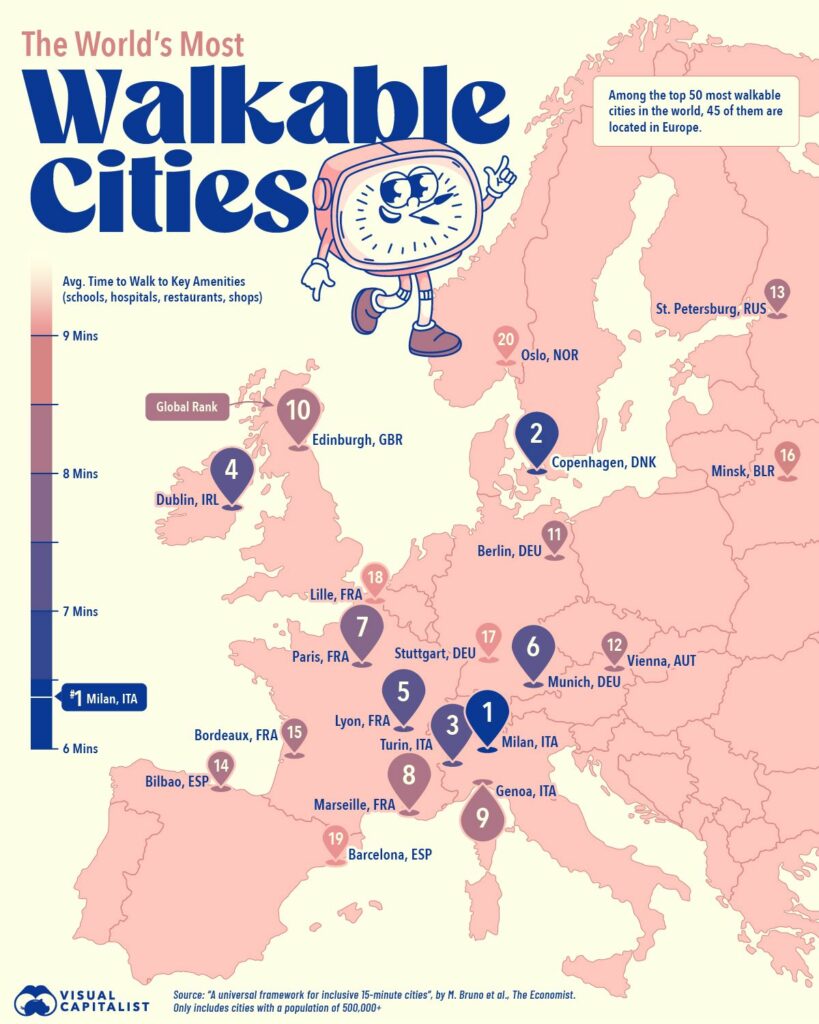
If so, European city centers are already leading the way.
At the heart of the 15-minute city concept lies a powerful idea: urban life should be organized around proximity —residents being able to walk or cycle to essential services within a short timeframe. And where is this model already most visible? In our historic city centers.
City centers, with their compact design, dense mix of services, and vibrant public spaces, are the natural birthplace of 15-minute living. They’re walkable by design, shaped long before the dominance of cars, and continue to play a central role in the daily lives of millions across Europe.
A new study published in Nature (September 2024) by Matteo Bruno, Hygor Piaget Melo, Bruno Campanelli, and Vittorio Loreto examined accessibility in cities with over 500,000 inhabitants. The researchers measured average walking times to core urban services—schools, hospitals, shops, restaurants—based on the 15-minute city framework.
What they found:
- Significant disparities within and between cities, often shaped by population density and urban planning.
- City centers consistently outperform peripheral zones in walkability and access to essential services.
Top 10 Most Walkable Cities (Average Walking Time):
1️⃣ Milan, Italy – 6 min 24 sec
2️⃣ Copenhagen, Denmark – 6 min 36 sec
3️⃣ Turin, Italy – 7 min 6 sec
4️⃣ Dublin, Ireland – 7 min 24 sec
5️⃣ Lyon, France – 7 min 24 sec
6️⃣ Munich, Germany – 7 min 30 sec
7️⃣ Paris, France – 8 min
8️⃣ Marseille, France – 8 min 6 sec
9️⃣ Genoa, Italy – 8 min 6 sec
🔟 Edinburgh, United Kingdom – 8 min 12 sec
➡️ These cities have one thing in common: vibrant and accessible centers that anchor urban life.
Why City Centers Matter
City centers are not just historical or commercial hubs—they’re also:
- Engines of social interaction, where culture, commerce, and community meet.
- Spaces of sustainability, where reduced reliance on cars and better public transport allow for greener living.
- Laboratories of innovation, where new uses of public space, pedestrian zones, and service clustering are tested and scaled.
In short, the 15-minute city model often starts in the center, before expanding outward.
Outside Europe?
The most walkable non-European city in the study is Kyoto, Japan (28th), followed by a few others in Asia. No North American city reached the top 50 — Vancouver, Canada, came closest at 53rd.
Rethinking the Role of City Centers
While many European city centers are already walkable, the challenge now is to extend their benefits to surrounding neighborhoods—and ensure that central areas remain livable, inclusive, and well-served.
The authors suggest a shift from time-based planning toward value-based planning: recognizing that what people need from a city center can vary—whether it’s a nearby school, a daily market, a park, or a cultural venue. The goal isn’t uniformity, but responsiveness to local needs.
In conclusion: The 15-minute city is more than a trend—it’s a revival of what our city centers have long embodied. For Europe, this is not about reinventing the wheel, but reaffirming the central role of the cœur de ville in shaping sustainable, inclusive urban life.
More Information
